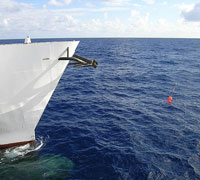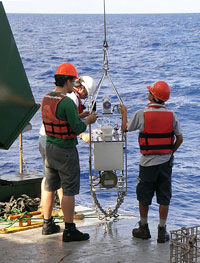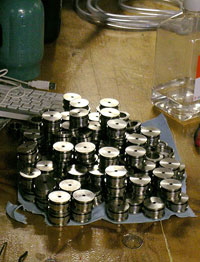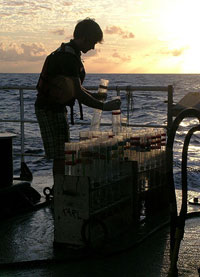- C-MORE Home
- What is Microbial Oceanography?
- What is C-MORE?
- Research
- • Research Cruises
- » BioLINCS
- Home
- Cruise Participants
- Instruments Used
on the Cruise - Nitrogen Cycling
- Marine Microbes
- Cruise Blog
- Data Archive
- Education & Outreach
- People
- Publications
- Image Library
- Contact Us
| |||||||||||||||||||||||||||||||||||
BioLINCS Cruise Blog
Monday, September 19, 2011
|
John Waterbury watches as the Kilo Moana pulls alongside a spar buoy. Craig Taylor’s Incubating Productivity Systems (IPS) and Submersible Incubation Device (SID) are suspended on a long cable beneath this buoy. |
|
Deniz Bombar and Kuhio Vellalos help recover the Submersible Incubation Device (SID), the last of the many instruments that we sent out to drift with the currents. |
|
Roman Marin III explains to Daniela del Valle how MBARI’s Environmental Sample Processor (ESP) works. On the right side of the photo, you can see this complicated robotic instrument sitting on a cart next to its titanium pressure housing. |
|
These little metal containers are called “pucks.” They are used inside the Environmental Sample Processor (ESP) to filter water, move samples around inside the machine, treat the samples with various chemicals, perform RNA analysis, and archive filtered samples for later study. |
|
As the sun sets behind the Kilo Moana, Ben Rubin cleans two of the 144 Lagrangian Sediment Traps and prepares them for their next deployment. |
This morning, after breakfast, we fished our last bit of drifting equipment out of the water. This was the mooring containing Craig Taylor’s Incubating Productivity Systems (IPS) and Submersible Incubation Device (SID). I walked from the galley up on the bow to watch the beautiful cloud formations, and there it was—its red floats and spar buoy poking up on the horizon.
Fortunately, the recovery of this mooring went more smoothly than yesterday’s recovery of the Environmental Sample Processor (ESP). Craig had already recovered his instrument four days previously, and noticed a problem with the recovery line wrapping around his mooring (similar to what happened with the ESP yesterday). Before Craig put his instruments back in the water, he adjusted a swiveling connector that allowed the mooring to rotate with the recovery line. This seemed to solve the problem.
After the last of Craig’s instruments was safely on deck, you could feel everyone relax just one more notch. We no longer had to worry about any of our gear floating around out there, getting tangled, breaking loose, losing radio contact, or simply disappearing beneath the waves.
An old truism in oceanography is “Never put anything in the ocean that you cannot afford to lose.” Of course, scientists do this all the time, because otherwise you’d never be able to do research (especially cutting-edge research). We were actually pretty lucky on this cruise. We had at least six different drifting instruments in the water at various times, and we got all but one of them back.
Two days ago we recovered the surface mooring of one of the “gas arrays,” only to discover that all of the six submerged frames with incubation bottles had separated from the surface mooring. We spent some time searching the sea surface to see if the frames were drifting around nearby, but we never found them. This was a blow to the science crew, who were counting on the data from the arrays. It will also pose a challenge for the marine operations staff, who were counting on using these arrays in another cruise that leaves later this week.
After Craig’s gear was stowed away, I went into the ESP lab, to see how well that instrument had survived its challenging recovery. Roman Marin III showed me a stack of stainless steel “pucks,” which had held the samples that the instrument had collected during its 10 ½ days at sea (as well as various filters and reagents). He said that all the runs had been successful and all of the samples had been archived and were ready to take back to the lab. He added that the instrument had been running at full speed the entire time it was at sea, analyzing a full set of samples for a dozen different microbes every 16 hours.
Over the next day or so, the ESP team will perform calibration runs on the machine to verify that all of the DNA and RNA detection systems are working properly. The team is confident that the ESP worked well, because they monitored the actions of the machine and the data it returned in real time. But these additional tests are a “double check,” designed to make the analytical results of from this robotic laboratory acceptable to the most demanding scientific journals.
Over the past few month, the ESP team has had to overcome its share of challenges. Just before the cruise there was a short in a circuit board, and new networking/communications software that had to be finished off at the last minute. They had to build the ESP its own air-conditioned box to keep the instrument cool. During the deployment, they lost contact with a few monitoring sensors, and at the end they had to deal with a results of a mooring float that thought it was a ballerina (spinning around and around and tangling its lines).
Through it all, however, the team and the instrument kept working, and returned great data. As Roman put it, “The success of this deployment, as well as the ESP project as a whole, is due to the fantastic ‘make it work’ attitude of the people at MBARI.”
Elsewhere around the boat, experiments continue to wind down. The last sediment-trap samples were processed and stored today, and some researchers are starting to pack up their lab equipment and get it ready for shipping. The UC Santa Cruz and MIT teams are performing their last incubation experiments, and are continuing to collect seawater for DNA analysis on shore.
We started to head back to port today, but we weren’t exactly racing for the barn. Every nine miles, we stopped the ship and took a CTD cast to collect seawater. The idea is that we will collect samples of seawater from other parts of the eddy in which our instruments have been drifting for the last 10 days (as described in my blog entry for Sept 10). This way the researchers will know how conditions around the ESP and the other drifting instruments compare with conditions in other parts of the eddy.
There’s an old Native American saying, which runs something like, “You can think about life once the fish is in the canoe.” I’ve noticed that, now that all our instruments are on board the ship, conversations among the science crew have started to expand beyond experimental protocols and who’s running the next CTD cast. You hear people discussing books, movies, family, past experiences and future dreams, as well as broader scientific topics, such as which types of research should be performed by robots, and which are better undertaken by live humans.
For almost two weeks, we on the ship have been isolated in our own little world. We have had little interaction with day-to-day activities on shore. Our concerns have been local, immediate: How can I get this instrument to work properly? Is the wind going to pick up? Is it dinner time yet? Now we need to start thinking like normal, land-based human beings. This is actually a little hard to do when you can still see water extending to the horizon in all directions. I’m sure once that we reach the dock, stepping back on land will be both a relief and a challenge.
[ Top of Page ]








